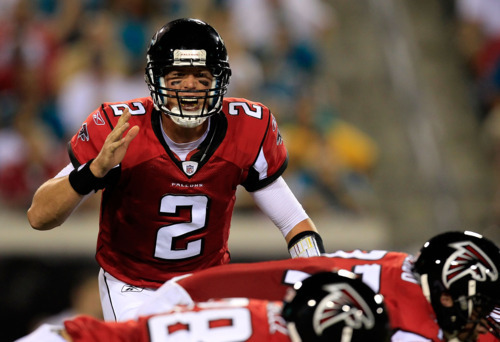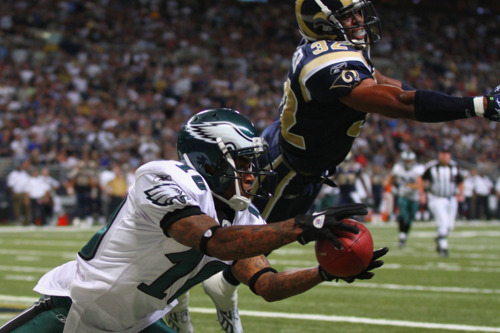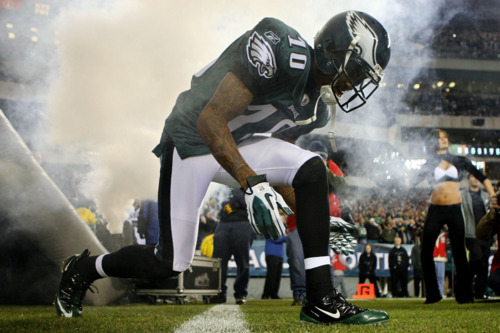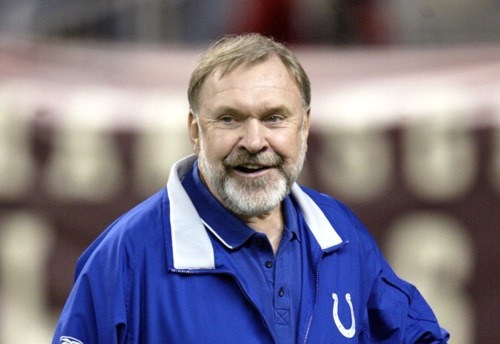Flashing lights appear to be a theme this year.
Week Two
Philadelphia Eagles @ Atlanta Falcons
8:20 pm ET on NBC
Flashing lights appear to be a theme this year.
Week Two
Philadelphia Eagles @ Atlanta Falcons
8:20 pm ET on NBC

Over at Bleeding Green Nation, Route36 had a nice video rewind, looking just at the Eagles run defense. He comes out of that exercise much more optimistic about the linebackers than when they went in, mostly based on their improvement over the course of the game.
It’s an interesting study, but I’m not convinced yet.
First of all, assigning positive and negative grades to plays based on outcome seems quite arbitrary. There aren’t many I disagree with, but it’s odd when plays marked as “Chaney misses the tackle which would have allowed only 4 yards” is listed as a positive play for the defense. If you mark a few of those negative, then you’re very quickly at the point where the Eagles are at equal good and bad plays. That doesn’t seem like the makings of a good run defense to me.
Furthermore, saying that all runs 5 yards or more are “negative” doesn’t quite cut it. For example, 7 of the 10 plays marked negative actually allowed 10 yards or more. If we classify those as “super negative” plays for the defense, things don’t look quite as rosy.
Second, I don’t really see the case for discounting the first quarter performance. A defense that has many poor plays is likely to give up some big runs, like the one they allowed to Steven Jackson. And as I intimated earlier in the week, it might be more appropriate to only look at the first half, since the second half quickly got away from the Rams. When the game was close, they were shredding the run defense. I’m sure a better team like the Falcons hopes to keep the game competitive and pound away.
Third, we do all remember that Jackson got hurt early in the game, right? I’m not encouraged by the defense allowing worse than the league average on running plays to castoff backs like Cadillac Williams and Jerious Norwood.
Finally, there’s the matter of attributing credit and blame. Rewatching these plays only reinforces the notion in my mind that if the defensive line doesn’t do something to stop the run, it’s going to be a bad play. The vast majority of “positive” examples of run defense involve one or more defensive linemen making the stop or otherwise causing it. When the Rams got past the first line, the linebackers rarely did anything to stop the bleeding. In other words, the Rams “second level” rushing yards were still very high - a bad sign for the linebackers.
Overall I’m still hopeful that the run defense and specifically the linebackers can improve, but I just don’t think we saw enough last Sunday to tell us that process is already underway. If the Eagles can limit Michael Turner this week, then we’ll talk.
Photo from Getty.

Seeing as we’re at the midweek point, perhaps it’s time to take a gander at the Eagles upcoming opponent to see what we might expect out of this weekend’s game. On Sunday the Eagles play the Atlanta Falcons in Michael Vick’s big return. Remember, last year Vick was injured against his former team and Kevin Kolb led Philadelphia to victory in his absence.
In preparation for the matchup, I went back and watched the Falcons week one loss against the Bears. Honestly, I didn’t find much to be worried about.
Let’s start on defense, where the unit looks average at best. They mostly played a vanilla 4-3 scheme with infrequent blitzing. The Football Outsiders Almanac said that the Falcons had more zone blitzes than anyone else in the NFL in 2010, but I didn’t notice that. Not that I would mind if they did. Defensive end John Abraham, like Trent Cole the last few years, is far and away the best pass rusher they have. Dropping him back into coverage only helps the offense.
The Falcons defense added Ray Edwards in the offseason, and at his size he’s hard to miss. But even against the Bears rookie tackle Gabe Carimi, Edwards made hardly any impact. Sean Weatherspoon is a tremendously fast linebacker, but made a couple of missed tackles that even Asante Samuel would be ashamed of.
Atlanta had an especially hard time covering Matt Forte on screen passes. Forte had two long gains, one for a touchdown and one that should have been a touchdown if not for a bad officiating call that put him out of bounds at the one yard line. LeSean McCoy must be licking his lips.
The Falcons offense has better weapons on paper than the Rams, but they barely registered because Matt Ryan looked so mediocre. The typical pass play involves Ryan dropping back with plenty of time and then dumping the ball off to the open man underneath. I’m all for taking what the defense gives you, but Roddy White and Julio Jones were nonfactors against the Bears.
For a while I thought it might just be the Bears cover two scheme, but then I checked the stats from last year. Ryan was 26th among quarterbacks in yards per attempt (6.5) and 28th in yards per catch (10.4). And while he’s decisive with the football, Ryan isn’t particularly mobile. That’s especially bad considering his left tackle Sam Baker had nine blown blocks in 2010 according to the FOA, third-most in the league.
Overall, this looks like an overrated team. Last year Atlanta won 13 games but their Pythagorean wins were closer to 11. They don’t look significantly better, while the Eagles have improved substantially since their 2010 victory.
All in all this will be a more difficult test than week one, and any further lapses in run defense or tight end coverage won’t make it easy on the Eagles defense. But if those holes can be patched up, I don’t see much reason to expect anything other than a 2-0 start.
Photo from Getty.
Video rewinds are always fun, and a kind soul has posted a few of the Eagles vs. Rams highlights on YouTube already. Let’s break them down a little bit, shall we?
Here’s Brian Westbrook in a 2006 shovel-pass touchdown… er, I mean LeSean McCoy in an updated version of the same play. The key to this working is the offensive line. Jason Peters and Evan Mathis let their guys come up the field, while Todd Herremans, Kyle DeVan, and Jason Kelce engage forward immediately like on a run.
DeVan (the newest CamelCased addition) knocks his defensive tackle to the ground and proceeds to lie down on top of him. That Rams defender should be glad Howard Mudd likes relatively skinny linemen. Also notice the speedy Kelce run a circle around Herremans, trying to catch the middle linebacker. No way Jamaal Jackson comes close to making that play.
Above is the Quintin Mikell strip-sack. The offensive line actually does a good job here, and so does LeSean McCoy in blitz pickup. But Brent Celek had to choose between a linebacker and Mikell. Ultimately this mistake is probably on Michael Vick, who needs to see the safety blitz and anticipate DeSean Jackson getting open in the end zone. If he let the ball go instead of waiting for Jackson to get open, that would have been a touchdown instead of a fumble.
Here again DeSean lines up in the slot. I don’t remember much of this from last season, but it’s smart down in the red zone, where his quickness can still be deadly without the threat of the deep ball. And here it works again to get Jackson free. He ends up paired off with Mikell, who simply can’t keep up once he’s beat.
Rolling Vick out gives him four options: run himself, dump off to McCoy, pass to Jackson, or try to sneak one in to Celek. The Rams linebacker Poppinga reads it well and closes on Vick, almost breaking up the play.
On this one you’ll notice the Rams brought seven defenders, but the Eagles only had six blockers. Celek slips out of the backfield and is wide open underneath. But such is the downside to having a quarterback who’s only six feet tall: there’s no way Vick could see Celek in that spot.
So this is destined to be a sack. Herremans gives a weak push to the blitzing safety and McCoy struggles to pick up the linebacker coming up the middle. Meanwhile the rest of the Rams defenders are keeping pretty solid containment around the pocket. Then again, I guess no one can really account for Vick, who proved that you can trip, slip, and stumble your way to the first down if you want it badly enough.

You all watched the Eagles beat the Rams 31-13 on Sunday afternoon. The score was convincing, even if the performance was more mixed. Let’s go inside the numbers to see what worked and what didn’t, and what we might takeaway for next week.
19 = The Eagles total rushing yards in the first half from running backs. That was on 9 carries for a pitiful 2.1 yards per carry. The Eagles ran a number of classic Howard Mudd stretch plays in the first half, and the blocking was horrible on almost every one. Not sure why the line looked so unprepared to handle those calls, but LeSean McCoy was scrambling like a mad man for a yard here or there. They settled down more in the second half, although mixing in some straightforward runs seemed to help.
118 = The Rams total rushing yards in the first half, by contrast. This figure is obviously helped by the big Steven Jackson touchdown run, but even without it the Rams still averaged over 5 yards per carry. By the end of the game things weren’t as bad, but that was largely because the Rams had to throw more to catch up. I’ll have to watch again to check this qualitatively, but Jamar Chaney was the only Eagles linebacker to get tackles at an above average rate.
6.7 = Rams yards per passing attempt to wide receivers. This is an astoundingly low number for a team that was trying to throw its way back into contention for most of the second half. Now, the Rams were a dink and dunk passing game last year and were plagued by drops yesterday. But for the most part the Eagles vaunted cornerbacks shut down all outside passes.
5 and 10 = Sacks and hits on the quarterback caused by the Eagles defensive line. Last season, the line had only 27 sacks and 52 quarterback hits — total. After one game, the unit is already one-fifth of the way there.
6.8 = Sack rate on all Eagles quarterback dropbacks in 2010. It was exactly the same in this game despite, or perhaps because of, the revamped offensive line. And while Michael Vick scrambled to safety (and daylight) on only 9 percent of pass attempts last year, he did so at more than twice that rate on Sunday. Many folks saw improvement in the second half pass protection, but Vick only had 8 pass attempts and 3 completions. The passing game wasn’t much more in sync.
Overall, when there was pass protection to speak of, Vick shredded the Rams defense. And once the Eagles gained the lead, the attacking defensive line and shutdown corners are built to stymie any comeback. That bodes well for the future, but the offensive line and linebackers will have to improve early and often next week if the Eagles want the same result against a better team in Atlanta.
Photo from Getty.
I would be nervous too if I had shelled out big bucks for a Nate Allen jersey. But if Merrill Reese the Keebler Elf, hinge-hipped cheerleaders, and oddly compelling strobe-lit cartoon dancing doesn’t get you ready for the season opener, there’s always the classics to fall back on.
Week One
Philadelphia Eagles @ St. Louis Rams
1 pm ET on FOX

With the pessimist fan’s guide already done, it’s time to turn to the dreamers, the optimistic few in this City of Brotherly Despair. These precious souls are always looking for the best, expecting another Super Bowl run. There’s no reason to jump off that bandwagon now. Eventually you’ll be right, and here’s why that could come this season:
Last year’s Eagles team had a tremendous number of problems. There was a quarterback controversy, a miserable right side of the offensive line, not enough pass rush, weak linebackers, and a giant hole at right cornerback that sucked in any unsuspecting player who tried to fill it. And yet, the Eagles still managed to go 10-6 and win the NFC East. And they could have easily been 11-5 if they played their starters in the season finale. This wasn’t a bad team in 2010.
Remember all those problems I just laid out? The Eagles addressed all of them in the offseason. Some of the spots went from areas of weakness to immediate strengths. Cornerback is now the deepest unit in the league. The defensive line has been upgraded with two big free agents. Offensive line and linebacker may not yet inspire confidence, but there’s no doubt that change has come to both positions and improvement wouldn’t be that difficult.
If you watched Thursday night’s NFL season opener, you saw the blueprint for a great team: a transcendent quarterback, spread offensive weapons, a relentless pass rush, and shutdown cornerbacks. That describes the Super Bowl champ Packers perfectly, and now the Eagles too. Forget the preseason. This Andy Reid-coached, Michael Vick-led passing attack will set franchise records. The defense, in turn, is built to feast on opponents who struggle to keep up.
If there was ever a schedule made for winning a playoff bye week, this is it. The NFC East looks like it’s in a down cycle. The Cowboys got back Romo but had lots of other turnover. The Giants lost a number of starters to injuries and free agency just in the last month. And the Redskins are starting Rex Grossman. Meanwhile, the Eagles take on the NFC West, another four wins. Then they play Atlanta instead of New Orleans and Chicago instead of Green Bay. Looking at the schedule, there’s no reason the Eagles can’t go 12-4 or 13-3.
Many contrarian commentators want to play down the Eagles’ chances because it’s always fun to hate. But this team has as good a chance as any in the Andy Reid era of finally breaking through and bringing home that elusive Lombardi Trophy.
Photo from Getty.

The perception of Howard Mudd seems to have shifted since training camp began, as Mudd went from a mythical offensive line genius to a real coach who makes some downright questionable decisions. In the last month he’s kicked to the bench productive veterans just because they didn’t meet his standards, forced a new and completely opposite blocking system on his players, disrupted the stable parts of the line, promoted inexperienced rookies to starting spots with the team, and then pulled one out again.
Considering one of the hallmarks of a good line is consistency, these changes don’t bode well for keeping Michael Vick off his back. I had reservations a couple months ago, back when I only had circumstantial evidence for Mudd being overrated.
Then it was a just question. Now it’s a certainty in my mind. Mudd rode a decade-plus of seemingly great lines in Indianapolis to achieve his respected status. Turns out, that was probably a lie.
Back in July, I described how Mudd’s lines ruled Football Outsiders’ Adjusted Sack Rate, a statistic that takes into account total sacks, pass attempts, situation, and defense. The Colts were either first or second in the NFL for Adjusted Sack Rate in ten of the twelve years he was their coach. And the only two years in which the Colts weren’t that high, their offensive line was still ranked in the top ten.
The problem is, that doesn’t take into account the quarterback effect of Peyton Manning, which in this case is huge. Peyton has successfully avoided sacks his entire career, despite pressure that his offensive line let through.
To prove this, all we have to do is look at the sacks and pressure stats collected by Pro Football Focus. In 2008 and 2009, the average NFL offensive line gave up pressure on the QB on 15.4 percent of pass attempts and sacks on 3.6 percent of attempts. On average, offensive lines gave up one sack for every four non-sack pressures. In other words, for every five pressures there was one sack — a reasonable conclusion.
The Colts, during that same span, gave up fewer sacks: only 1.4 percent of all attempts. And yet the line also allowed much more non-sack pressure than average: 18.6 percent of dropbacks. In the end, Manning was sacked only once for every 14 non-sack pressures, an incredibly low figure.
Let me reiterate. The Colts line gave up over 20 percent more regular pressure than the average club. And yet they allowed fewer sacks. Presumably, Mudd isn’t some rogue genius at preventing pressure from becoming sacks. That quality would fall on probably the best quarterback in the NFL over the last decade, who’s arrival in Indianapolis happened to coincide with Mudd’s.
Mudd may still be a good hire, we can’t know how he’ll do in Philly. But his reputation appears largely undeserved — more of a lucky pairing than any particular coaching brilliance. And that only further highlights the questionable offensive line shakeup he’s undertaken since he arrived.
Photo from Getty.